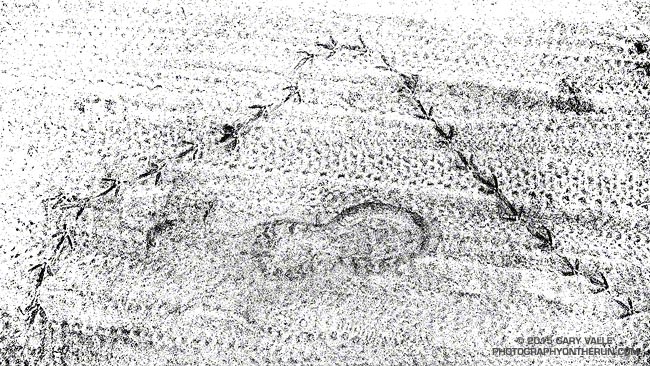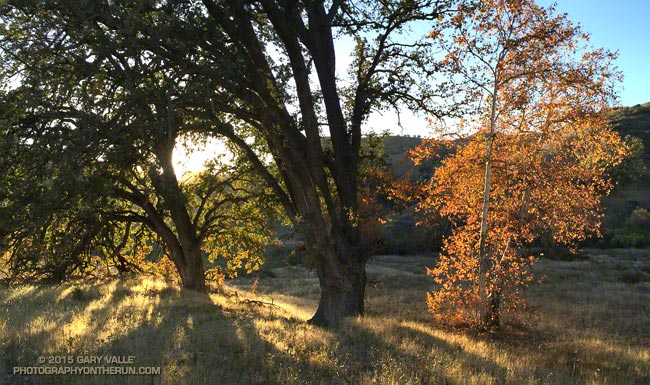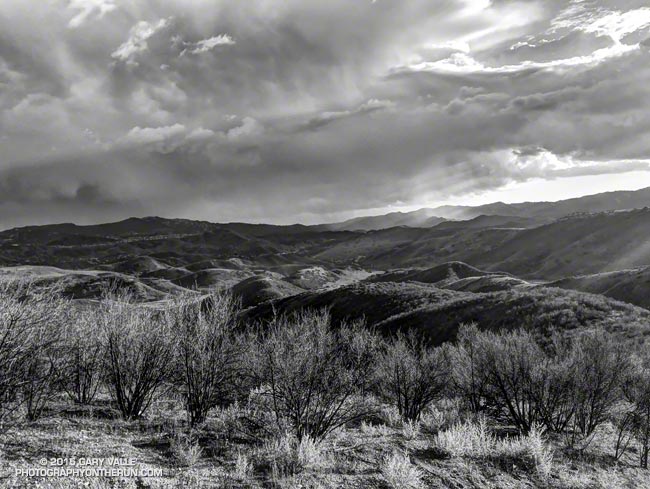
Sunrise on the way to Cheeseboro Ridge.

Sunrise on the way to Cheeseboro Ridge.

Tracks of California quail and other wanderers in Upper Las Virgenes Canyon.

From this morning’s run to Simi Peak.

From yesterday afternoon’s run in upper Las Virgenes Canyon.

Due in part to El Nino and the Madden-Julian Oscillation (MJO) Southern California jump-started the 2015-16 rain season with above average rainfall in July and September.
Last year the NWS changed the WATER Year to October 1 – September 30, but the RAINFALL Year remains July 1 – June 30, as it’s been for decades.
Below is the monthly tabulation of rainfall for Downtown Los Angeles (USC) for the 2015-16 Rainfall Year, along with what is considered normal for the month.
| Month | Rainfall | Normal |
|---|---|---|
| July | 0.38 | 0.01 |
| August | T | 0.04 |
| September | 2.39 | 0.24 |
| October | 0.45 | 0.66 |
| November | 0.01 | 1.04 |
So far this rainfall year Downtown Los Angeles (USC) has recorded 3.23 inches. Even with November as dry as it’s been we’re still more than an inch above normal for the rainfall year — about 1.46 inches above normal as of November 25.
Over the next couple of weeks the medium range models and other tools aren’t especially bullish on our chances for a good, soaking rainstorm in Southern California. Longer term guidance suggests an improving chance of precipitation as December progresses, and above average precipitation in January and February. We’ll see!
The title photo is from November 3. It shows a band of thunderstorms that moved southward across the San Fernando Valley and into the Santa Monica Mountains. The band produced cloud to ground lightning strikes and some heavy showers. Saddle Peak is in the distance on the left. The shower activity in the distance on the right is in the area of Kanan Rd. and the 101 Frwy.

Sprouting new leaves as if recovering from a wildfire, this drought-stressed valley oak at Ahmanson Ranch benefited from the unusual amount of rain in Southern California during July and September.

Between July 1 and October 1, the Cheeseboro RAWS, located on a hilltop about two miles away, recorded more than two inches of rain.
Here’s what the tree looked like in 2011, before the drought.
Update January 15, 2021. “The Tree” died in the Spring of 2020, when Ahmanson was closed due to COVID-19. Although scorched in the Woolsey Fire, it never recovered from the 2011-2015 drought, and that appears to have been the primary cause of death.
Some related posts: Ahmanson Valley Oaks Battling Drought, It Was So Muddy (Again) That…, A Two Mud Run Summer and Wet Winter Outlook for Southern California